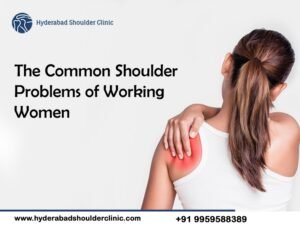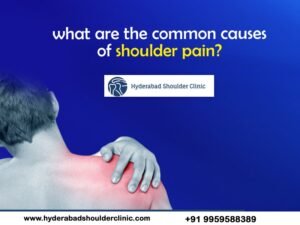Every year, thousands of cases of conventional shoulder replacement are successful in shoulder arthritis patients all across India. However, this type of standard surgery is not very useful for patients with massive rotator cuff tears, and who have developed a sophisticated type of shoulder arthritis called cuff tear arthropathy. In these patients, shoulder joint replacement can cause pain and limited movement, then reverse shoulder replacement is a better choice.
Patients with shoulder arthritis usually suffer from shoulder pain and mobility problems. Shoulder has an intricate connection with a socket, consisting of arm bones, ball, and shoulder blades (sockets and roof).
Shoulder movement is possible by a series of muscles that surround the shoulder and is called a “rotator cuff”. Arthritis is a process of wear and tear on the joint cartilage. There are two types of arthritis in the elderly: one with an intact rotator cuff on the shoulder and the other without a rotator cuff. Treatment of complicated problems like this must be done by specialized shoulder surgeons to get good results.
In patients with uncomplicated shoulder arthritis, shoulder replacement that maintains the connection between the ball and the socket leads to excellent results. However, arm anatomy replacement results are reduced in patients with more complex arthritis after injury.
With advances in technology, Dr Chandra Sekhar has been able to control shoulder arthritis with muscle tears or after injury with a new prosthesis called reverse shoulder replacement.
This article provided by Dr Chandra Sekhar B will help you to know regarding the reverse shoulder replacement surgery.
Reverse Shoulder Replacement Surgery:

Regular shoulder replacement surgery devices mimic normal anatomy of the shoulder, a plastic cup is inserted into the shoulder cavity (glenoid), and a metal ball is attached (humerus) to the upper arm bone. In the case of a reverse shoulder replacement, the socket and ball get exchanged. A metal ball is attached to the socket, and a plastic cup is attached to the top of the shoulder humerus bone.
Reverse shoulder replacement works better for people with arthritis and total cuff tear. In a healthy shoulder, rotator cuff muscles support the position and movement of the arm during the range of motion. Conventional replacement also uses rotator cuff muscles to function correctly. These muscles no longer function in patients with massive rotator cuff and arthropathy. Total reverse shoulder replacement depends on the deltoid muscle instead of the rotator cuff to place the shoulder joint in position.
Why is this shoulder prosthesis called a “reverse” prosthesis?

With a standard shoulder replacement, the shoulder gets replaced by a metal ball and the socket by plastic parts.
In reverse shoulder replacement, the shoulder joint is made with metal and plastic components. The big difference between a reverse prosthesis and a standard replacement is that the prosthesis places the ball on the socket side of the joint. The socket is placed on the side of the arm, and it is supported by a metal stem on the humerus bone. In this way, the ball and the socket are reversed away from the natural way.
Candidates for reverse Replacement Surgery:

Reverse total shoulder replacement recommended by a doctor if you have:
- Rotator cuffs are fully torn and cannot be repaired.
- Cuff tear arthropathy.
- Previous shoulder replacement that didn’t work.
- Severe shoulder pain and difficulty lifting the arm from the side or the top of the head
- Complex shoulder joint fracture
- Chronic shoulder dislocation
- Shoulder tumour
- Other treatments such as rest, medication, cortisone injections and physical therapy do not reduce shoulder pain
Why should someone get a reverse shoulder surgery instead of a standard shoulder replacement?

Standard shoulder replacement depends on how intact are the muscles and tendons around the shoulder. The muscles are attached to the shoulder blades and turn into tendons attached to the shoulder. These muscles and tendons move the shoulder and are collectively called the rotator cuff. If these tendons are so torn that they no longer get attached to the bone, the shoulder often does not function normally. Loss of rotator cuff can cause pain and loss of movement. Normal shoulder replacement only works if the tendon is still intact. Conversely, reversible surgery is designed for situations where the rotator cuff is damaged or not functioning.
Surgery Overview:

Operational experience is similar to a standard shoulder replacement with few variations. The main factor in recovery is whether this is the first replacement of the shoulder arm or whether the old prosthesis must be removed during surgery. In this case, this is referred to as revision and recovery may be different from when the joint was first replaced (known as “primary” replacement).
Surgery is usually done with an arm nerve block followed by general anaesthesia. The incision is on the front of the shoulder, and the operation takes about two to three hours. Postoperative pain relievers are given orally and intravenously using pain relief if necessary. Most patients can move their fingers, wrists, and elbows the next day.
Whether arm movements can be done the next day after surgery depends on how well the base plate and ball are mounted to the socket with screws. In reverse operation, the prosthesis has a specific dependence on bone healing around the base plate and screw. As a result, shoulder movements can be stopped for several days to several weeks.
Despite these precautions, most patients are allowed to eat, read, or use the keyboard with their hands within a few days of surgery. How much a patient can lift their arms depends on many factors and each patient is different. The shoulder movement allowed after surgery also depends on the fixation of the screw to the bone, which are determined during operation. Finally, it also depends on how much the patient’s shoulder movement was before the surgery.
The operating time for reverse surgery is more extended (three to five hours) and the recovery time for obtaining hand functions is also longer. Other factors that affect recovery time include whether a bone graft is being performed, whether the bone is holding correctly, and how long it will take for the bone to heal.
Conclusion:
Reverse shoulder replacement surgery is perfect for pain relief, and patient satisfaction is usually very high. The level of pain relieved is very dependent on the reason why the procedure is done. The level of pain relief in revision cases is slightly lower than the first surgery, which may be caused by scarring and long-term damage.
After rehabilitation, a patient may be able to lift arms slightly above shoulder height and bend elbows to reach the top of your head.
If you have shoulder problems that may require shoulder replacement, contact Dr. Chandra Sekhar. B at 9959588389 for an appointment as he is one of the best shoulder experts. To know more details about the doctor, visit https://www.hyderabadshoulderclinic.com/about-us/.





